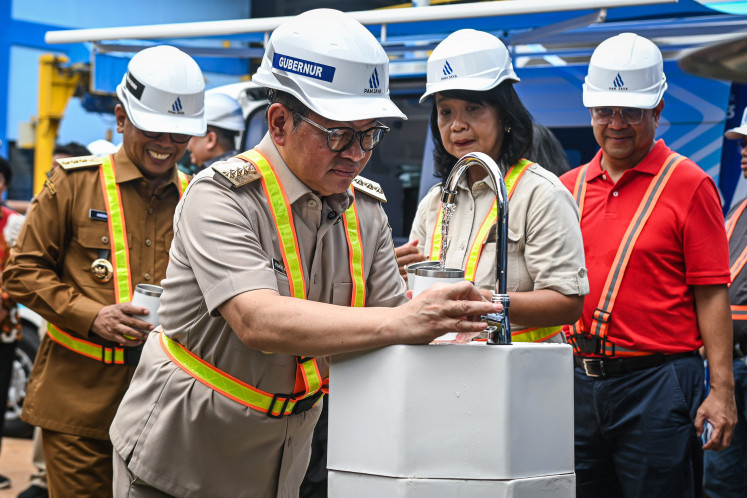Popular Reads
Top Results
Can't find what you're looking for?
View all search resultsPopular Reads
Top Results
Can't find what you're looking for?
View all search resultsThe gene of outcomes in public service
Nearing to the end of his first term, President Susilo Bambang Yudoyono launched a bureaucratic reform program for three central agencies: the Ministry of Finance, the Supreme Audit Agency and the Supreme Court
Change text size
Gift Premium Articles
to Anyone
N
earing to the end of his first term, President Susilo Bambang Yudoyono launched a bureaucratic reform program for three central agencies: the Ministry of Finance, the Supreme Audit Agency and the Supreme Court. The initiative was designed to boost public trust in these organizations and the government in general.
These agencies drew up their reform plans, which contained “quick win” activities and proposed innovative actions for simplification of business processes, improved accountability, organizational modification and changes of personnel. As an incentive the agencies were eligible for special remuneration packages that ranged from four to nine times the prevailing public service base salaries.
When he won his second term with an outright majority, the President heralded bureaucratic reform as among the top-priority programs of his new administration.
The Grand Design for Bureaucratic Reform (GDRB) 2010-2025 and Road Map for Bureaucratic Reform (RMBR) 2010-2014 were enacted under Presidential Regulation No. 81/2010.
As a high-profile policy making body, the National Steering Committee for Bureaucratic Reform (NSCBR) was formed with Vice President Boediono as chairman. NSCBR formulates strategic policies for bureaucratic reform. The committee also selects the ministries or non-ministerial agencies that would be designated as pilot agencies for reform.
The selection was conducted by an executive body, the National Taskforce for Bureaucratic Reform (NTBR), chaired by the minister of Administrative Reforms. The day-to-day operation of the national program is run by the National Bureaucratic Reform Implementation Unit (NBRIU), coordinated by a deputy minister at the Ministry of Administrative Reforms.
GDBR 2010-2025 is very ambitious, as it states the ultimate goal of the bureaucratic reform is to intensify public confidence in the government.
The final goal can be achieved through the following intermediate goals: to realize good and corruption-free governance; to meet the needs of citizens and companies for quality of public services; and to improve institutional capacity and accountability of the civil service.
Eight areas for modification are identified in the GDRB: improving public service delivery; organizational refitting; business process reengineering; regulatory trimming; selection and appointment of “agents of reform”; monitoring and evaluation; accountability; and implanting a culture of results.
The reform program was expanded to 14 ministries and agencies in 2009-2011. Some sub-national governments also started to reform their public service, although their number was less than 2 percent of the total number of provinces, regencies and municipalities.
The overall objective of the reform program was quite ambitious: by 2015 all national agencies, 35 ministries, 28 non-ministerial agencies and approximately 50 statutory agencies are expected to complete implementing bureaucratic reform.
All sub-national levels, including 33 provinces and 497 regencies and municipalities, are expected to implement bureaucratic reforms by 2025.
Indonesian bureaucratic reform was ready for a massive transformation resulting from internally led reform initiated by ministries and agencies and an externally led reform program directed by national policy.
But the daunting obstacles to bureaucratic reform persisted and prevented objectives from generating significant improvements in public service performance.
Enthusiastic support for bureaucratic reform was not driven by sincere belief in efficiency and high-performance civil service, but because most leaders and staff at government agencies wrongly perceived the reform as “remunerative reform.”
The intermediate impacts of this “remunerative reform” were found in the 2011 state budget and regional budgets. Management and personnel expenses accounted for approximately 38 percent of total national expenditure for 2011, compared to 29.1 percent in the 2010 state budget.
The impact of this misperceived reform would be catastrophic if local governments followed suit. Management and personnel expenses of local governments have averaged between 70 and 82.5 percent of their budgets. Local governments would have no motivation to support bureaucratic reform without additional transfers from the central government.
The paths Indonesia can follow in its bureaucratic reform program were discussed in a stakeholders’ forum conducted by the NSCBR Policy Advisory Team in April, attended by the Swedish ambassador and senior officers from donor agencies. The main message from this series of stakeholder forums is straightforward — Indonesia needs to learn from other countries, avoid their mistakes and adopt their success stories.
In short, Indonesia should better focus its reform program on limited services much needed by citizens and the business sector, identify quick wins leading to longer-term solutions and start from there.
Strong commitment and political support from top leadership is key to successful implementation of bureaucratic reform.
This commitment must be shown to the people, the business community and especially to members of the civil service.
The present GDBR also needs a total review, as it gives too much emphasis on processes and less on outcomes. Even worse, according to University of Indonesia professor of public administration Prasojo, these processes are based on functional structures at the ministry in charge of the reform effort rather than relevant processes that affect performance of bureaucratic reform.
Continuing development of the transformers shall also become the center of Indonesian bureaucratic reform programs as they are ultimately the actual “force” for successful reform.
A national training program designed to produce a cadre of transformation leaders at operational, managerial and policy making levels is urgently needed. More effective instructional methodologies must be employed to instill these “gene of outcomes” expected by citizens and businesses in selected civil service personnel, internships in successful business, civil society and public organizations, and of course, appropriate incentives.
Indonesia can learn from other countries about how to best motivate 4.7 million members of its civil service to support this massive but important program of reform. Relying solely on remunerations as incentives for fostering reform would make the already inefficient government too expensive and become a major roadblock for sustainable bureaucratic reform.
Indonesia can learn from French President Sarkozy, who launched a major bureaucratic reform program in 2007 to improve efficiency in his government and use part of the money that an agency can save as incentives for the employees.
The writer is a professor of public policy at Gadjah Mada University and a senior UNDP-Indonesia decentralization advisor.










